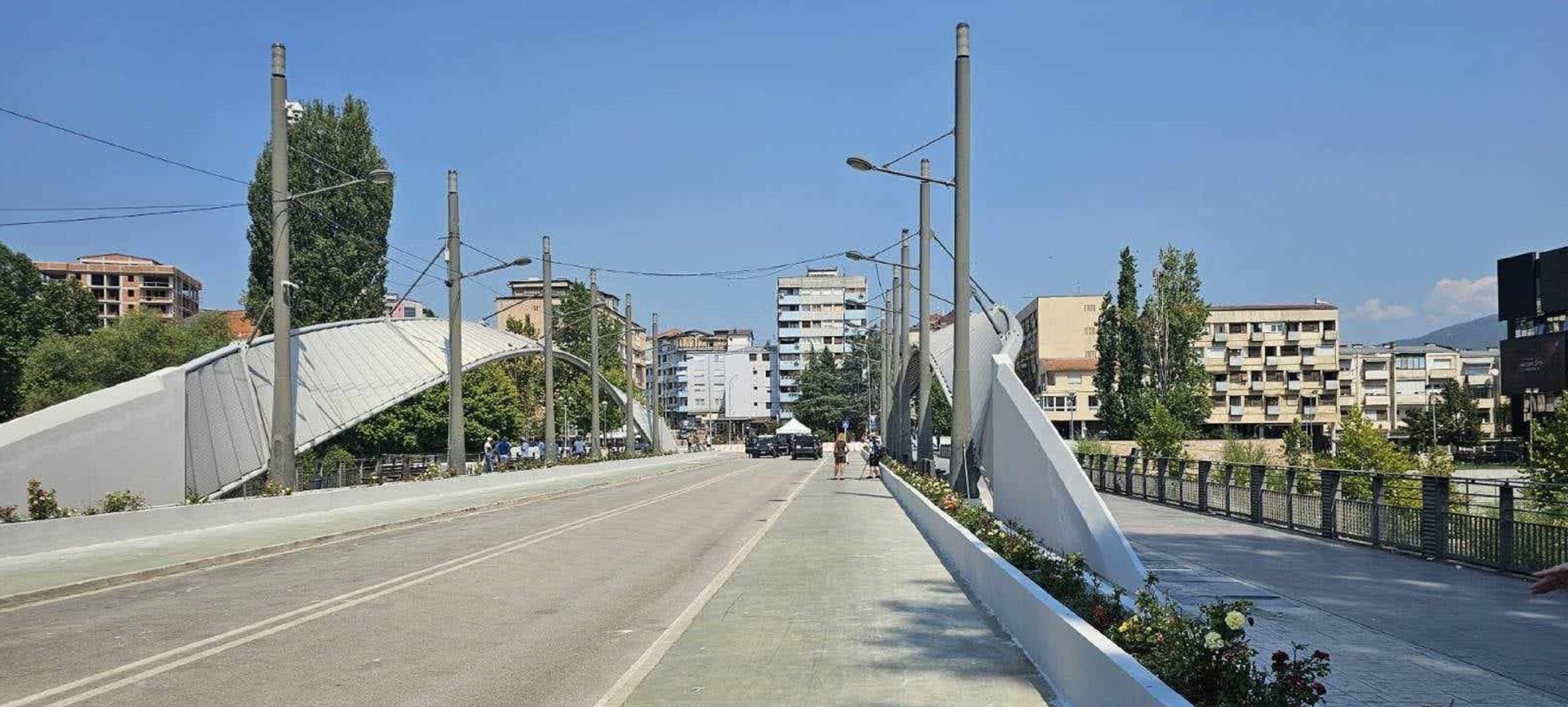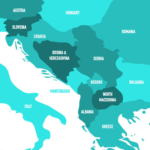The bridge over the Ibar between the northern and southern parts of Kosovo Mitrovica remains shut down to traffic. Despite preparatory technical works carried out by the Kosovar side, traffic was never relaunched on the dates previously announced informally (August 14-15).
A technical inspection of the bridge was completed in early August, and a tentative assessment released by the Kosovo Ministry of Infrastructure shows that the bridge is safe for traffic. But the process of launching it has stopped at this point.
Consultations will continue
At a government meeting on August 14, Prime Minister Albin Kurti of Kosovo emphasized that the opening of the central bridge in Mitrovica for vehicles is “the right and necessary thing, beneficial for everyone.” At the same time, he said Pristina would continue consultations and coordination with international partners on the issue of reopening traffic. “We will continue consultations and coordination with our partners. The opening of the bridge is not against anyone, especially against our partners,” Kurti emphasized.
The statement came against the background of protests by Serbs in Northern Mitrovica, alarmist signals from Belgrade, and warnings from the EU and USA.
Serbian President Aleksandar Vučić claimed that Pristina planned to open the bridge over the Ibar “by force” on August 14-15. He stated that he expected “further provocations” from the Kosovo authorities and called on KFOR to prevent the “unilateral” opening of the bridge in Mitrovica.
Vučić’s words can be seen as a warning of possible clashes between the Kosovo authorities and local Serbs, who are categorically opposed to the opening of the bridge over the Ibar to traffic. The main argument “against” the move is that the traffic across the central bridge of Mitrovica will threaten the security of Serbs in the North.
On August 7, hundreds of Serbs protested against the Kosovo government’s decision to open the bridge, demonstrating their determination to prevent Pristina’s plan from being implemented.
Bad timing
The message about possible clashes in the north of Kosovo due to the opening of the bridge in the West was taken rather seriously.
The NATO mission in Kosovo, KFOR, assured that it remains a guarantor of stability, but stressed that the decision to open the bridge should be agreed within the framework of the Kosovo-Serbia dialogue under the auspices of the European Union.
“We will not hesitate to tackle any development that may affect the security environment and regional stability, in full respect of our UN mandate,” KFOR said in a press release on August 6. “Any decisions regarding the opening of the main bridge over the Ibar/Ibër river must be made within the framework of the EU-facilitated dialogue between Belgrade and Pristina.”
Representatives from European countries and the United States tried to convince Kurti to abandon the idea of opening the bridge immediately. All QUINT (United States, UK, Germany, France and Italy) nations have announced that they do not currently support the opening of the bridge.
European Union spokesman Peter Stano recommended that Pristina to open the bridge unilaterally and to heed to its friends and allies. “I can only recall for all those who have a problem with listening and understanding that all the friends and allies of Kosovo (EU, US, NATO, UK…) have said very clearly and unequivocally that it is in the interest of Kosovo to listen to friends and allies, otherwise, one runs the risk to be left alone and left behind,” noted Stano.
The Americans were more specific and harsh in their comments.
The U.S. Ambassador to Pristina, Jeff Hovenier, said that opening the bridge in Mitrovica under the current conditions would create a real security risk and would directly threaten the safety of NATO soldiers in Kosovo, including American ones.
“We believe there is a real risk associated with taking this action right now, and we believe that this risk increases threats—it could potentially lead to violence and create other problems, both for the local community and for NATO soldiers, including American soldiers who are working to ensure peace and security in Kosovo,” Hovenier said in an interview.
The topic of the opening of the bridge in Mitrovica is set to be included in the agenda of the next meeting of the Pristina-Belgrade dialogue in Brussels. However, the date of the meeting is yet to be determined.
A symbol for everyone
It is necessary to remind once again that there are three more bridges across the Ibar in Mitrovica, and all of them are operational (!). But the central bridge has a special meaning.
First, it is symbolic, as a site that became the center of major clashes between Serbs and Albanians in previous years. The full opening of the bridge – not only for pedestrians, but also for traffic – is perceived by many as a signal of the end of the conflict, reconciliation, and a sign of the reintegration of the Serb north into the state body of the Republic of Kosovo. It is clear that the Serbs, who in principle do not recognize the independence of Kosovo, are not happy with such symbolism.
Belgrade uses the symbol of the bridge in its own way. For Vučić, the closed bridge is proof that he “didn’t give up Kosovo”, continuing to fight for it.
On the other hand, Albin Kurti is trying to symbolically affirm the sovereignty of Kosovo in the northern territories by opening the bridge. On February 9, 2025, parliamentary elections will be held in Kosovo, and the full opening of traffic on the bridge over the Ibar, which will become a symbol of the accession of the north of Kosovo, will make the victory of the Kurti (Vetëvendosje) movement almost guaranteed.
Kurti’s position on the inevitability of the opening of the bridge rests on another story of symbolism, the European one.
A few years ago, Brussels wanted to make the central bridge in Mitrovica a symbol of the solution to the Kosovo issue. An EU-brokered agreement between Belgrade and Pristina in 2016 stipulated that the bridge would be opened to traffic on January 20, 2017. At the time, the agreement was presented as a success, and the renovated bridge over the Ibar was a symbol of the success of the Kosovo-Serbia negotiations under the auspices of the European Union.
However, the positive reports from officials do not always correspond to the reality on the ground, and the bridge was never fully opened, while all formal decisions in this regard have been made. Accordingly, from a formal point of view, it is possible to explain the position of Pristina, which simply seeks to complete what was already agreed upon a long time ago.
Freezing as a solution
The second – and special – meaning of the bridge is safety. Of course, this is not about any fundamental strategic importance of the structure. But, in simple terms, Kosovo police or security convoys would be able to reach the center of Northern Mitrovica – pretty much the main city of the Serbs of Kosovo – quicker and more conveniently via the central bridge. Of course, the local Serb community is far from amazed about it as people remain unfriendly towards the Kosovo authorities, if not outwardly hostile.
The third meaning of the bridge is hybrid. The “half-closed” bridge can be and is used by the Serbian side as a tool for keeping the conflict simmering and blackmailing the international community. The message of potential clashes, articulated directly by Vučić, is a vivid example of such an approach.
In fact, the bridge that remains closed is beneficial to supporters of keeping the conflict in a frozen state rather than finding a solution. However, at this stage, it is obvious that this tactic (or strategy?) of “freezing”, preserving the existing status quo, is dominant not only in Belgrade, but also in Brussels and Washington. The tactical goal is clear – to preserve peace and to prevent the frozen conflict from reigniting. But the big question is whether it is possible to guarantee peace in the long term by pursuing a policy of concessions to actors who seem more dangerous. Sometimes, these concessions even involve snubbing the previous agreements.


